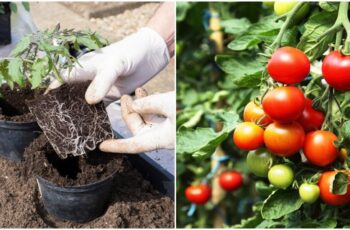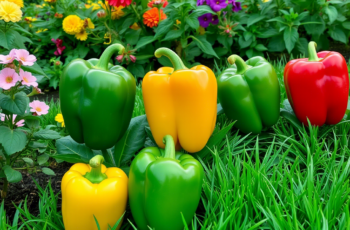Ad Blocker Detected
Our website is made possible by displaying online advertisements to our visitors. Please consider supporting us by disabling your ad blocker.
The most straightforward approach to pruning tomatoes is to do it regularly while the suckers are still young and tender. Depending on your gardening style and the size of your garden, you have the option to leave tomatoes unpruned or prune them once or multiple times throughout the season. However, many gardeners prefer to regularly prune indeterminate tomatoes during spring, summer, and fall to simplify the trellising process.
The primary focus of tomato pruning typically revolves around managing tomato suckers, which have a rapid growth rate and divert the plant’s energy away from fruit production. To stay on top of tomato suckers, it is recommended to inspect your indeterminate tomato plants every 7 to 10 days throughout the growing season.
When you spot any suckers, it is easiest to remove them while they are young and can be easily pinched away using your fingers. By staying consistent with this practice, you can effectively maintain the growth and productivity of your tomato plants.
How to prune tomatoes
When it comes to pruning tomatoes, adopting a “less is more” approach is often recommended to ensure you don’t hinder the plant’s ability to nourish itself or provide shade to its fruit. Whether you are dealing with indeterminate or determinate tomato varieties, the following tips for tomato pruning can assist you in cultivating healthier plants. However, it’s crucial to remember that when in doubt, it’s safer to err on the side of caution.
Over-pruning tomatoes can potentially cause more harm than allowing the plants to grow naturally. So, if you’re uncertain about the pruning process, it’s best to exercise restraint and let your tomato plants flourish with minimal intervention.
Pruning determinate tomatoes
Over-pruning can pose specific challenges for determinate tomato varieties. Determinate tomatoes have a smaller growth habit and cease growing once they reach a specific size, making them suitable for small gardens.
Due to their compact nature, determinate tomatoes generally require minimal pruning, and excessive pruning can significantly diminish your tomato harvest. This is because determinate tomatoes set all their flower buds at once, and pruning these buds will prevent the plants from regrowing new flowers for fruit production.
However, while it’s generally advised to avoid extensive pruning of determinate tomatoes, it is recommended to pinch off any suckers that emerge between the soil line and the first cluster of tomato flowers. This practice directs the plant’s energy towards fruit production without removing the essential buds needed for further fruit development.
For those unfamiliar with tomato suckers, they are small branches that sprout between the main stem and side branches of tomato plants. Suckers often grow at a 45-degree angle and can be easily pinched off when they are small. However, if suckers become larger, it is advisable to use garden pruners to remove them in order to prevent damage to the tomato plant.
In addition to removing lower suckers on determinate tomatoes, it is also beneficial to eliminate any leaves near the bottom of the plant that comes into contact with the soil line. This practice helps maintain cleaner tomato leaves and reduces the spread of common tomato diseases such as blight.
Pruning indeterminate tomatoes
Indeterminate tomatoes have a tendency to develop numerous non-fruit-bearing suckers, which can drain the plant’s energy and impede tomato development. These suckers divert valuable resources away from fruit production and can lead to smaller tomato harvests.
Pruning indeterminate tomatoes offers several benefits, including easier plant management and the ability to cultivate large tomatoes even in limited garden spaces. Additionally, pruning redirects the plant’s energy towards fruit production, resulting in an improved harvest and enhanced flavor of the tomatoes.
Various pruning styles and techniques exist for indeterminate tomatoes, and each gardener may have their preferred approach. Below are some recommended suggestions, but feel free to experiment with different pruning methods based on your own plants.
It is important to avoid pruning more than one-third of your plant’s foliage at a time, as excessive pruning can expose the tomatoes to sunscald and place undue stress on the plant.
At planting
Pruning for indeterminate tomatoes should commence early on, starting from the moment you plant them in your garden. Whether you opt to grow tomatoes from seeds or purchase tomato starts from a local nursery, new plants generally require pruning when they are transplanted.
To prune newly planted indeterminate tomatoes, it is advisable to pinch off any buds or flowers that have already developed before planting. This redirection of energy towards root and leaf growth aids in the plant’s successful establishment in your garden.
Additionally, you can selectively remove some of the lower leaves along the tomato plant’s stem and bury the stem deeper into the soil. This encourages the development of additional roots, providing enhanced stability as the plant grows. More roots also enable the tomato plant to absorb increased nutrients and water, resulting in accelerated growth and improved overall plant health.
Lastly, it is important to snip away any tomato leaves that come into contact with the soil after planting. This practice helps minimize the spread of tomato diseases, promoting healthier plant growth and reducing the risk of infection.
During the growing season
Regular pruning during the growing season offers several benefits, including improved airflow, directed energy, disease control, and reduced plant damage and healing time. By removing suckers when they are young and tender, these advantages can be maximized.
During the initial stages of your tomatoes’ growth in the garden, it is advisable to continue pinching off any flowers they produce until the plants reach a height of around 12 to 18 inches. This practice promotes taller growth and helps the plants establish themselves more efficiently.
Throughout the growing season, it is important to regularly pinch away any suckers that develop between the soil line and the lowest cluster of flowers on your tomato plants. Additionally, remove any lower leaves that come into contact with the soil to minimize the risk of plant diseases. Plucking off yellow leaves not only improves the appearance of your plants but also aids in overall plant health.
If desired, you can further prune the suckers on your tomato plants to enhance airflow and shape the plants according to your preference. Depending on the type of tomato support system you are using, you may choose to remove all but the central main stem or leave up to three suckers attached to the main stem, allowing them to thicken and create a bushier tomato appearance.
In cooler climates, it is common for gardeners to remove the entire sucker from tomato plants. However, in hotter regions, an alternative approach known as “Missouri pruning” is often employed. With this technique, only the top of the tomato sucker is removed, while the lower two leaflets of the sucker are left intact. This allows the leaflets to grow and provide shade to developing tomatoes, reducing the risk of sunscald.
When pruning suckers, it is best to do so when they are young to minimize injury to the plants. Small stems can be pinched off with your fingers, while larger stems will require the use of a sharp knife or pruners. Checking your tomatoes for suckers every 7 to 10 days ensures that they are removed before becoming too large.
At the end of the season
To ensure your tomatoes ripen before the arrival of fall frost, a strategic pruning technique called “topping” can be employed approximately one month before the anticipated first frost date. Indeterminate tomatoes have a tendency to continue fruiting throughout the end of summer and into fall. However, concerns may arise as the season progresses, with worries that the tomatoes won’t ripen before the onset of cold weather. This often leads to a rush to gather green tomatoes when frost is predicted.
Fortunately, a well-timed pruning practice can aid in ripening tomatoes on the vine earlier, making fall harvests more convenient. Topping tomatoes involves removing or cutting away the top growing tips of the tomato plants. This halts further growth of the plant and redirects its energy and sugars towards fruit development. By employing topping, tomatoes are more likely to ripen at a faster rate on the vine. Additionally, any green tomatoes that remain have a higher chance of fully ripening, should they need to be brought indoors to protect them from frost.
By utilizing the topping technique, you can maximize the ripening potential of your tomatoes, ensuring a fruitful harvest before the arrival of fall frost.

